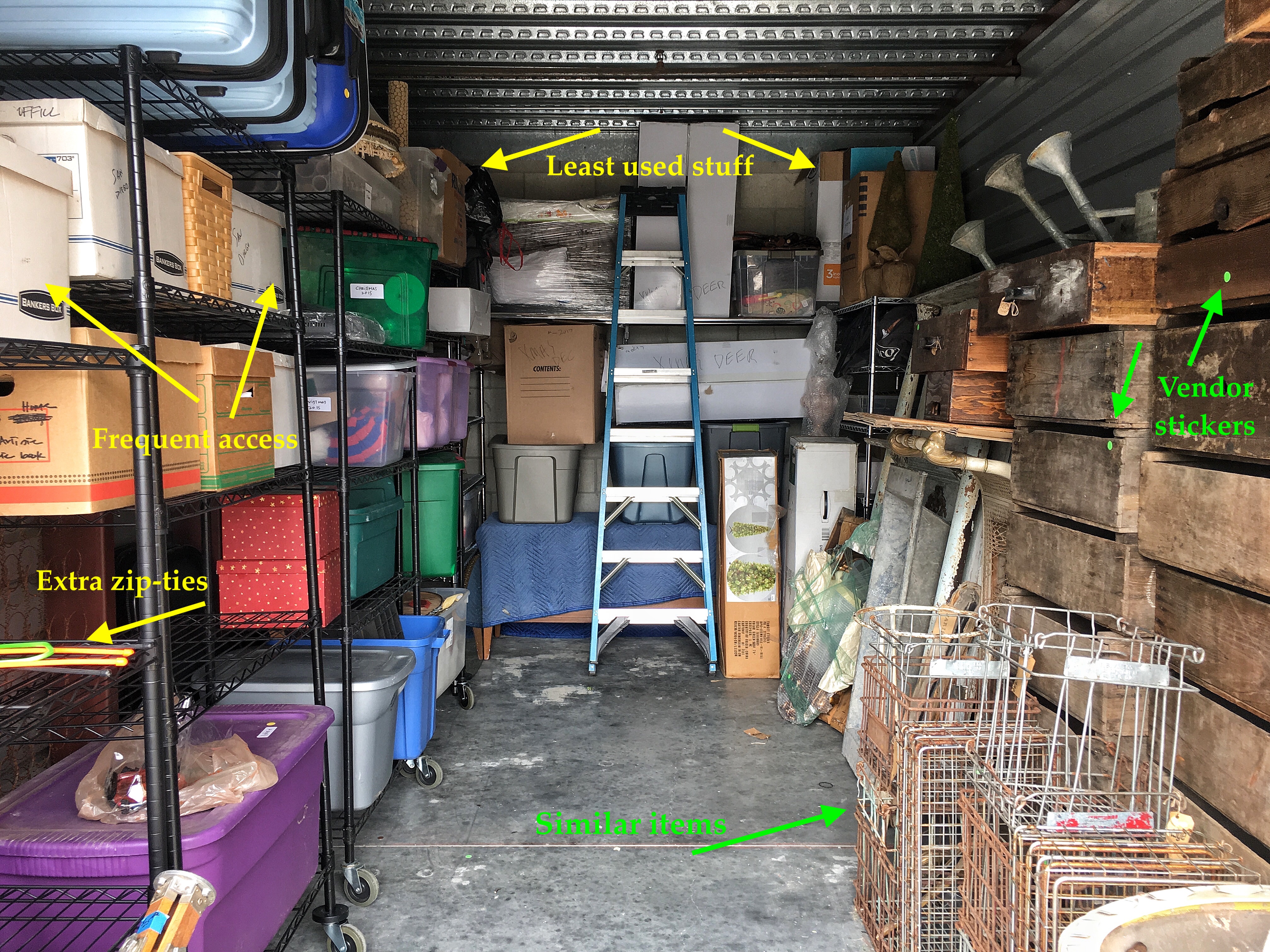Self-storage is a multi-billion dollar industry that feeds off the disorganization of its customers. Your stuff piles up, it becomes harder and harder to organize and when it overflows you need to buy more space. Their interest is not in organizing your stuff, but in selling you space.
Follow these steps and in no more than a weekend of work you can reduce you clutter, get at your stuff easier and maybe even cut down the number of units your renting to save you some serious coin. Setup cost will be higher, but your monthly cost will drop. Plus there is the peace of mind of having easy access to anything you have in storage.
Materials:
- Stickers, in at least 3 colors
- Permanent markers
- Garbage bags / bin
- Bins, totes, organizers
- Donation pick-up service, or address of a donation center
- Shelving
- Zip-ties, twist-ties, hooks and tension rods
- 4-8 straight rods or bars (I used closet rods)
- Work gloves
- Music or Podcasts (sorting shit can get boring...)
Love these bendy twist ties
Budget:
- 5' by 10' storage space = $80 per month
- Stickers & marking items = $15
- Zip-ties,etc =$17
- Organizers = $50
- Shelving = $179
- Est. Dump Fees = $59 Total = $80/month, $320 one-time
Ways You Can Save Money:
Find a charity that will pick up donations for free (I used a Vietnam Vets charity in SD)
Organize better - reduce your number of storage spaces, or size of needed storage space
Use labelled boxes instead of totes or plastic bins
Use recycle centers wherever possible, dump-runs get expensive (check your municipal website for passes they may give to local residents to use the dump)
Preparation:
Step 1 - Write out what you want to accomplish by organizing your space. Compile a list of addresses and phone numbers for stores, donation centers, recycling centers/town dumps or any other service you might use.
Step 2 - Create a visual system for sorting that can be easily communicated to anyone helping you or working for you. I recommend buying stickers in three colors that you can attach to boxes or items as you sort. It will help you to only have to do it once.
GREEN (Sellable)
YELLOW (Store / Keep)
PURPLE (Toss / Donate / Destroy)
Step 3 - Buy anything you need including stickers, markers, shelving, ties, hooks and other organizers. The person I was doing this job for wanted a fair amount of expensive shelving, which ended up costing about $500, but the same effect can be had for much less if you shop wisely.
Plastic shelving option / metal shelving option
Step 4 - Sort, label, toss and donate. Be ruthless. The more that you are willing to give away means more space to use now and in the future.
How To Think About Your Storage Space:
How can you use space both vertically and horizontally?
How do you want to access the most important things?
What about the weight of things that can be stacked together (heaviest on the bottom, obviously)?
Setting Up:
- Clear all the way to the back wall.
- Place the first pair of shelves in the two back corners facing each other.
- String a set of rods in between the shelves, attaching them underneath the top shelf with zip-ties. Space the rods far enough that they create a new platform you can stack on top of, as well as hang things from.
- Place items that you will need to access least often along the back wall, and corner shelves.
- Place items that you will access frequently along one wall, and towards the front of your space.
- Take pictures of your stuff and use a photo editor app like Moldiv or SnapSeed to superimpose labels over your picture. This will help you remember what is there, without having to actually go to your space to see.
Want to use a storage space as an inventory location for your business?
If you're interest in storage is professional instead of personal, you can easily turn a storage space into a cost-effective warehouse facility with just a few more tools.

My project was for a friend who sells a lot of antiques, and launches pop-up stores every so often. She wanted me to cut her 3 storage spaces down to 2, keeping 1 for her personal items, and 1 for inventory of her items for sale. Easier than it sounds:
Group similar items together, and place a visual marker on all items for sale (Green sticker)
Use pano photography to take shots of inventory
Make a database in Google Docs or Excel to inventory items by type, size, amount and other categorization that is useful to your business
Bonus if your storage location is 24/7 service. You can access it whenever your business needs and not worry about expensive insurance on a warehouse location.
Check out my few other posts on Steem @
- https://steemit.com/business/@almostfitz/open-for-business-11-pictures-about-launching-a-startup-speak-11-000-words
- https://steemit.com/shark/@almostfitz/i-binged-5-seasons-of-shark-tank-and-got-something-out-of-it
- https://steemit.com/dnn/@almostfitz/dnn-the-good-the-bad-and-the-ugly-on-how-to-create-a-decentralized-free-news-platform
- https://steemit.com/writing/@almostfitz/free-writing-cage-that-monkey-mind-and-get-creative
- https://steemit.com/data/@almostfitz/stop-wasting-time-168-hours-tracking-system
Check out my posts on my other blog @
Hi, I found some acronyms/abbreviations in this post. This is how they expand:
Downvoting a post can decrease pending rewards and make it less visible. Common reasons:
Submit
Nope! San Diego
Downvoting a post can decrease pending rewards and make it less visible. Common reasons:
Submit